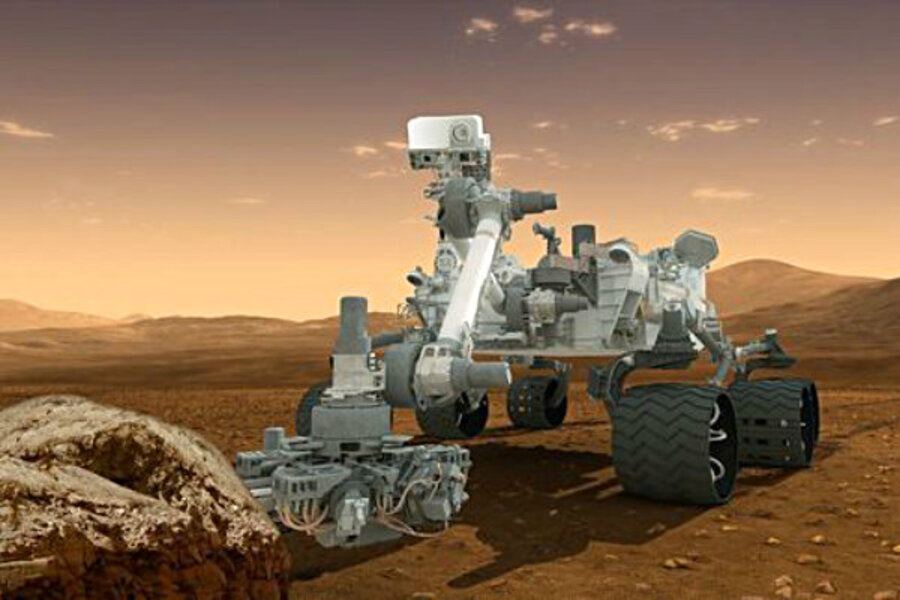Mars Curiosity rover to seek signs of life on Red Planet
Loading...
If we found life on another planet, the discovery would go a long way toward answering the deepest open questions in biology: How did life originate, how widespread is life in the universe, and are there alternative recipes for life?
There’s no obvious sign of life on any of our neighbors in the solar system. But desolate, frozen Mars keeps calling scientists back. In the Martian landscape, geologists see dry riverbeds and flood plains that hint at a warmer past that just might have allowed life to originate.
All life on Earth appears to be related, using DNA and RNA molecules to pass down assembly instructions and other information. We share stretches of this genetic code with bacteria, yeast and amoebas.
But if life originated on Mars, it might use a completely different way of storing and transmitting information. And so, if the Mars Science Laboratory lands safely next week, instruments will begin to analyze the soil, air and rocks for life, past or present.
The warm period was early in the history of the solar system — it looks to have begun freezing up by 3 billion years ago. The Martian atmosphere today is too thin to hold in much heat, but perhaps greenhouse gases once blanketed the planet and were later lost.
Experts say the nice period happened early — around 4 billion years ago. By 3 billion years ago Mars was already starting to dry up. But that somewhat balmier time corresponds to when life was getting started on our planet. According to chemical analyses in ancient rocks, life had already taken hold here 3.8 billion years back — not too long after the planet cooled off enough to have a solid surface.
The Mars Science Laboratory will release an SUV-sized rover called Curiosity into a crater where water just might have once pooled. Andrew Knoll, a professor of Earth and Planetary Science at Harvard, says he’s excited about some of the novel science the rover is equipped to do.
Some of its instruments will look for signs of methane and other organic compounds in the atmosphere. Others will seek them in the soil. Finding them wouldn’t necessarily mean Mars once had living matter, but the Curiosity rover could turn up new clues in the search for life there.
The fact that life started so early on Earth gives scientists some hope that it might have sprung up elsewhere in the universe. Life has also been found in some seemingly hostile environments — in Antarctic ice, boiling hot springs, and buried a mile underground living on geothermal energy and minerals.
One of the big challenges is being able to recognize signs of past life and not overreact to false alarms. In 1996, NASA made the explosive announcement that a team of researchers had found signs of fossil bacteria in a meteorite that fell to Earth from Mars. Organic compounds called polycyclic hydrocarbons resembled similar compounds made in living things here.
Soon after the announcement, though, biologists quickly pointed out that the shapes NASA thought were bacteria and the compounds could be explained by processes that involved no life. And so it all hangs in doubt.
One of those skeptical voices was paleontologist John Grotzinger, then at MIT and now at Caltech. NASA apparently doesn’t hold a grudge against naysayers since he’s now chief scientist on the upcoming mission.
There is little doubt, at least, that this rock, called ALH84001, and others like it did come from Mars. Tiny bubbles of trapped gas match the composition of samples studied by the Viking mission back in the 1970s.
The discovery that the rock and others originated on Mars opens up the possibility that life crossed the divide between the two planets. It’s slightly more likely that life would go from Mars to Earth, since Mars cooled off sooner and Earth is larger and therefore a bigger target.
Whatever Curiosity turns up, Mars does have a story to tell. The Mars Pathfinder mission in 1997 found evidence of massive past floods, during which water threw rocks and even boulders around the landing site. Still, scientists aren’t sure how much water flowed over Mars, how warm it got, or what kind of an atmosphere it had.
And nobody is quite sure what changed to make Mars into the dry, frozen wasteland it is today. “We don’t know what happened but we know it was something big,” said Grotzinger. “Even if life never evolved on Mars we would want to know what happened.”





